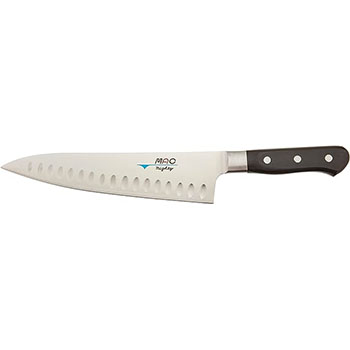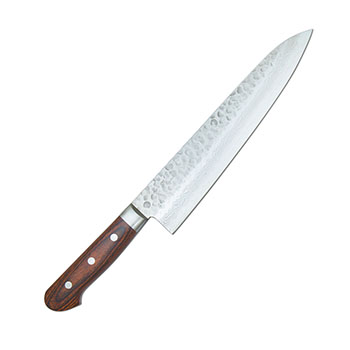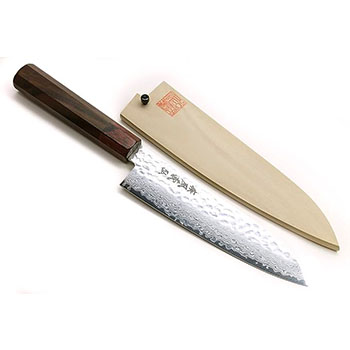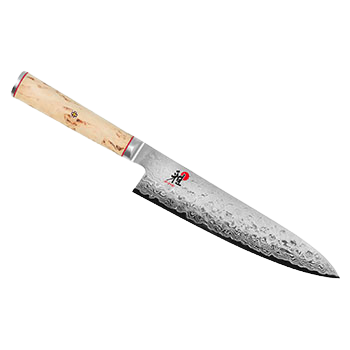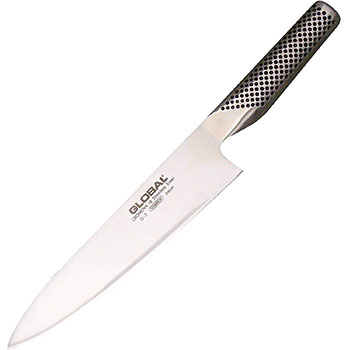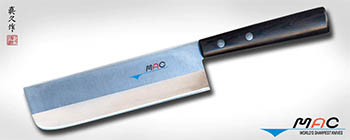The chef’s knife is the workhorse of the restaurant kitchen. This guide lists the most durable and affordable knives for professional kitchen use.
6 Best Chef Knives for Professionals [According to a Chef]
This article is part of a larger series on Restaurant.
The chef’s knife is the most important tool you can purchase, no matter what part of your culinary career you are in. This is the tool you will use the most during your time in professional kitchens, and your search for one is incredibly important. In this guide, I evaluated several knives on the market to give you the best options for chef knives in your kitchen. Use the suggestions below to pick the best chef knife for you.
The best chef knives for 2023 are:
- Best overall: MAC Professional 8-Inch Chef Knife
- Best gyuto: Togiharu Gyuto
- Best santoku: Yoshihiro Santoku Rosewood
- Best hybrid style: MIYABI Chef’s Knife 8-Inch
- Best affordable knife: Global 8-Inch Chef’s Knife
- Best nakiri: MAC Japanese Series Vegetable Cleaver
Best Chefs Knives Compared
Blade Type* | Steel Type | Blade Length | ||
|---|---|---|---|---|
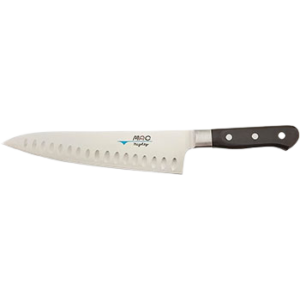 | $144 | Chef’s Knife/Gyuto Hybrid | Japanese, High-Carbon | 8 inches |
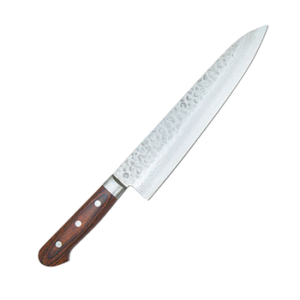 | $159 | Gyuto | Japanese, Layered Steel | 8.2 inches |
Buy the Togiharu Gyuto | ||||
 | $179 | Santoku | Japanese, Damascus Steel | 7 inches |
Buy the Yoshihiro Santoku Rosewood | ||||
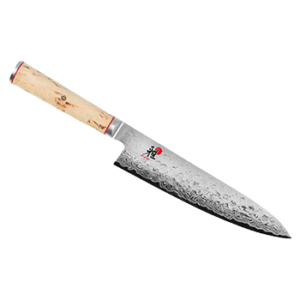 | $279 | Chef’s Knife/Gyuto Hybrid | Japanese, Micro Carbide Steel | 8 inches |
Buy the MIYABI Chef’s Knife 8-Inch | ||||
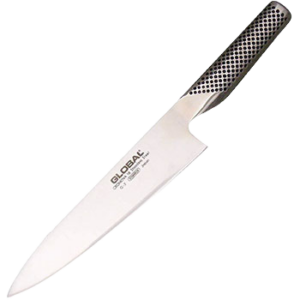 | $95 | Chef’s Knife | Japanese, Carbon Steel | 8 inches |
Buy the Global 8-Inch Chef’s Knife | ||||
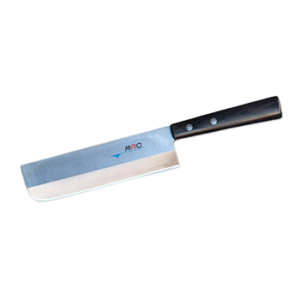 | $105 | Nakiri | Japanese | 6.5 inches |
*For descriptions of the different blade types, see our section on chef knife styles below.
Why You Can Trust Us
Ray Delucci is a food industry worker with over 10 years’ experience in the industry. He is a graduate of The Culinary Institute of America, class of 2018. His experience includes fast food, fast casual, hotels, catering, fine dining, and employee management. He has worked with and trained using a variety of knife types, allowing him to recommend the best knife for specific kitchen situations in this comprehensive guide.
Looking to start in the food business? Use our guide on how to start a restaurant to learn exactly what you will need to do to build a successful restaurant.
Best Overall: MAC Professional 8-Inch Chef Knife

Pros
- Very approachable yet effective knife
- Well-built handle that will help it hold up over time
- Dimples in the blade to help prevent food from sticking
- Respected brand in the food industry
Cons
- Hybrid style of the blade may be harder for some newer cooks to learn
- Learning to sharpen may take a few tries
The MAC Professional Chef Knife tops many lists as one of the best knives out there for cooks and for good reason. Its 8” style blade is perfect for any cook, allowing enough length to take on larger ingredients but short enough to perform precise cuts. The blade itself is made in Japan out of high-carbon steel, creating an extra durable knife that holds an edge for some time. Additionally, the handle is riveted, giving the knife extra support over sustained use. The dimples in the blade’s sides prevent food from sticking as you chop.
This knife has a 50/50 double bevel split on the blade, which makes it relatively easy to sharpen. Its hybrid gyuto/chef’s knife design may be new to some users, but with some practice and experience, the knife will perform extremely well. The ability to rock, while not having a giant curve, gives you more surface area to cut. Its pointed tip allows you even more control of cutting, making this knife extremely versatile. For all of these reasons, we chose the MAC Professional Chef Knife as the best professional chef knife in our guide.
Best Gyuto: Togiharu Gyuto

Pros
- Hammered Damascus finish
- Stain-resistant steel make
- Riveted handle
- 50/50 bevel
Cons
- Can be a harder style of knife to learn
- Sharpening may be difficult for newer cooks
Korin is one of the most respected knife shops in the world, and in-house brand Togiharu offers an excellent 8.2” gyuto ideal for any cook looking for this style of knife. Its blade is made out of Japanese layered steel with a Vg-10 steel core that offers an incredibly durable and sharp edge. This gyuto has a riveted hardwood handle, which makes using this knife comfortable while offering durability and support. The bevel is set at a 50/50 balance on the knife, ideal for both left- and right-handed users in any kitchen setting.
This knife has a beautiful hammered Damascus finish on the blade, which makes an especially nice contrast to the color of the hardwood handle.

Korin Inox Chef’s Knife (Source: Ray Delucci))
I myself use a Korin knife—their Inox Chef’s Knife—which has lasted me for years (and is pictured above). The chef’s knife I bought has a little bit of a more complicated bevel when sharpening, and can be bought only in-store at their New York location at the time of writing this. Korin is one of my favorite brands, and this Togiharu Gyuto is excellent for those wanting the more traditional Japanese-style knife.
Best Santoku: Yoshihiro Santoku Rosewood
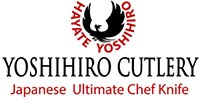
Pros
- Beautiful Rosewood handle
- Layered Damascus finish
- Stain-resistant steel
- Comes with a protective knife sheath
Cons
- No rivets in the handle for extra support
- Cannot be used on harder ingredients such as nuts or bones
Yoshihiro is one of the most respected Japanese knife makers in the world, known for great craftsmanship and excellently made knives. We recommend the Yoshihiro Santoku Rosewood in this guide. This beautifully designed Japanese-style knife is made of 456 layers of Damascus steel that is hammered to make the blade. The knife itself is super lightweight, weighing in at just 4.5 ounces. A beautiful Rosewood handle is perfect for easy gripping and offers a very elegant overall look to the knife.
This knife is meant for precision knife cuts and should not be used in butchery or extremely hard ingredient production. The flat blade and blunted tip make it the perfect knife for slicing, mincing, or chopping, and can give you the extreme control you need to attain the hardest knife cuts. Its lightweight build gives you a ton of balance to work with, and the 50/50 bevel makes sharpening easier than more advanced Japanese Santoku-style knives.
Best Hybrid Style: MIYABI Chef’s Knife 8-Inch
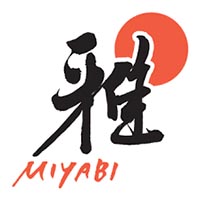
Pros
- Beautiful handle and blade design
- Hybrid balance between chef’s knife and gyuto
- Hand-honed blade
Cons
- Pricier than some other options on our list
- Birchwood handle may take some getting used to for newer cooks
- No added dimples for food release
ZWILLING, the popular German knife maker, acquired the MIYABI shop in Seki, Japan, and released its own line of Japanese knives to the general public. These knives blend German craftsmanship with Japanese methods and steel.
The MIYABI Chef’s Knife 8-Inch is an excellent cross between German and Japanese knife making. This beautiful knife boasts a Damascus finish and a Rosewood handle. The knife is a bit heavier than others on our list but can work through a variety of different ingredients to give you the best cutting experience. The bevel is set at 9.5 degrees to 12 degrees, making the edge of the blade exceptionally sharp. This also means that more skill is required to sharpen this knife. This chef’s knife is the perfect hybrid knife, and with a traditional Japanese handle, it can take some getting used to. But MIYABI is an excellent brand and one you can trust when purchasing.
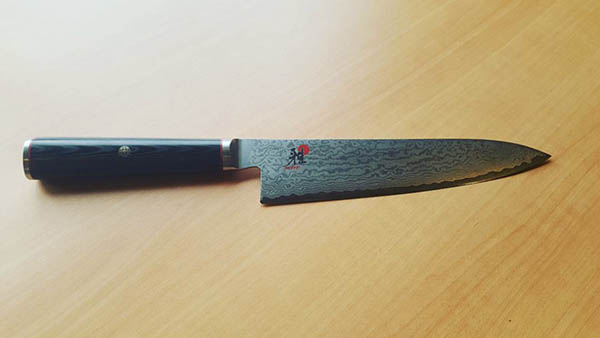
MIYABI Kaizen Knife (Source: Ray Delucci)
My first knife in kitchens was a MIYABI Kaizen Chef Knife, and it lasted me a very long time. This is a great brand for those venturing into Japanese blades. Check out the MIYABI Kaizen’s specs and pricing.
Best Affordable Knife: Global 8-Inch Chef’s Knife
Pros
- Very affordable chef’s knife
- Ergonomic handle
- Easy for beginner cooks
Cons
- Stamped instead of forged
- Blade may not hold edge as long
- No rivets or dimples in blade
The Global Chef’s Knife is an affordable knife perfect for any cook in the food industry. This knife is made in Japan and stamped out of a carbon steel sheet that is then honed to form the blade. It is very approachable and easy to use.
The ergonomic stainless steel handle makes this knife extremely durable, and it will last for a long time. While it may not hold an edge as long as other knives on this list, it can be sharpened with ease to regain that edge. The handle of a Global knife is slightly smaller than a traditional knife handle, making it easier to grip and work with. The bevel is also 50/50, making it uncomplicated to sharpen. Global knives have a cult following by many in the culinary world, and it is a small investment to see if their unique style is right for you.
This knife from Global is a great, all-duty knife to have on hand, especially if you are passing it on to front-of-house staff to borrow for light prep tasks or newer cooks to use during prep.
Best Nakiri: MAC Japanese Series Vegetable Cleaver

Pros
- Riveted handle
- Excellent for vegetable prep
- Easier blade to sharpen
Cons
- Only for vegetable prep
- No dimples in the blade
- Needs training to use properly
This nakiri-style vegetable cleaver from MAC is an excellent choice for those looking for this kind of blade for vegetable prep. The flat and wide blade offers you great cutting power through all sorts of ingredients, and the larger surface area allows you to accomplish more with your cuts. The riveted handle gives the knife support, giving you the confidence to tackle any vegetable ingredient that may come your way. Its blade is easy to sharpen due to having a very flat surface and a 50/50 bevel. This is an excellent knife for those looking for a nakiri-style knife to add to their toolkit.
Chef Knife Styles
As we all know, it’s important to have the right tools for the job. Different food prep activities require different knife styles and blades. Let’s take a closer look.
Chef Knife
The standard chef knife is the bread and butter of the restaurant industry. At 6 to 12 inches in size, this is the standard knife used in most professional kitchens. This knife is the workhorse knife of the restaurant industry, being used for different functions. From vegetable cuttery to small animal butchery, the chef knife is designed for a vast suite of applications. The blade is long, triangular, and curved, with a pointed tip that allows for both rocking cutting with the blade body and precision cuts with the blade tip. This is the ideal knife for most cooks and one that is made in a variety of ways.
Gyuto
The gyuto is the Japanese version of the chef’s knife. It offers a flatter blade and less curve than the standard chef knife, giving it more accuracy with the push/pull method of slicing than with the rocking motion of the style mentioned above. These knives can be used in a variety of ways, much like the chef’s knife, and are great additions to any knife kit.
Santoku
A popular Japanese design, the santoku knife can be compared to the chef’s knife but does have some differences. Used in precise chopping, dicing, and mincing, this style of knife is made for the experienced cook to provide exact cuts in the kitchen. A flat blade 5 to 7 inches in length, this knife often has a curved tip and a straight blade. This design gives you ultimate precision when cutting. While a santoku blade can be used in many applications, skilled cooks use it most often for more precise cuts.
Nakiri
The nakiri knife is a great tool for vegetable prep, designed specifically for this task. The blade of the knife is very flat, allowing for a wide cutting area when breaking down any vegetable that crosses its path. The blunt end of the blade makes slicing or push-cutting through ingredients super-efficient and fast. This is a must-have for any cook who does a ton of vegetable prep, especially precise cuts in larger volumes.
What to Look for in a Chef’s Knife
Below are the main points to consider to when choosing your chef’s knife:
Blade Style
The first notable feature to look for when choosing a chef’s knife is the style of the blade and how it cuts. As we shared above, there are many different types of blade types that cut in different ways. It is vital to understand the blade type you work best with and the type of cutting you will be doing the majority of the time. Be sure to pick a blade style that suits the needs of your kitchen and the ingredients you will be using.
Ease of Maintenance
People frequently overlook this when knife shopping, but your ability to keep the knife sharp is a major consideration. So many cooks—including myself—purchase knives that look cool and cut insanely well without the necessary knowledge on how to keep them sharp.
Buying a knife that you can easily and efficiently sharpen—keeping in mind that this will be done in off time away from work—is key to having a knife that works best for you. Also, understanding the sharpening style of the blade itself and how you need to sharpen it will determine if you are able to use that knife effectively.
Steel Type
The type of steel you choose, and more specifically, the region the steel comes from, is a huge determinant of how the blade will perform and what you can expect from the knife. For example, soft alloy steel, often used in German blades, may not hold their sharpness as long but are easier to sharpen.
On the flip side of that, a Japanese Damascus blade may hold its edge much longer but can also take much longer to sharpen and actually prove to be more difficult to maintain. Knowing the steel type ties into your ability to maintain the knife and also your general skill of using the knife in your day-to-day work.
Balance
The balance of a knife is the point where the knife naturally rests when you hold it. The best knives have a balance that feels natural to you. The balance and weight of a knife will be different as experienced by each user.
You want your knife to be an extension of your hand, so a knife you can easily work with and hold for long periods of time is extremely important. Noting how heavy a knife is, how the knife feels between the blade and the handle, and how fluidly you are able to cut with it are all key decision factors. A well-balanced knife prevents repetitive injury by removing a lot of effort from cutting and chopping.
Expected Tasks
In choosing a knife, you need to understand the type of ingredients you will be working with, the type of knife cuts expected at your job, and whether or not the knife can withstand the day-to-day use you will ask of it.
A workhorse German knife may be preferred in processing a lot of different vegetables and smaller meat cuts, as this kind of knife is designed to withstand this heavy workload. A Japanese santoku, however, may be the knife you want for precise knife cuts and garnishes that will be used to showcase your skill and the skill of the kitchen as a whole.
Budget
Your budget is another determining factor in the kinds of knives you may choose. Any cook can tell you that shopping for chef knives can be an expensive endeavor. But that being said, we all have a budget for our gear, so know the amount of money you are willing to spend on your knife. This will help limit the vast market of options available to you. Keep in mind this tool will probably be used more than any other out of your knife bag (the name speaks for itself), so be sure to give it adequate thought and investment.
How Our Expert Chose the Best Chef Knives
25% of Overall Score
25% of Overall Score
25% of Overall Score
25% of Overall Score
Best Chef Knives Frequently Asked Questions (FAQs)
There is no “best” steel generally for knives, but there can be the best type of steel for you. German steels are often softer but can take a lot more in regards to usage. They are easy to maintain and easy to work with. This makes them very popular amongst cooks.
Cooks also love Japanese steel as it is harder, can perform more precise cutting, though it does take more time to sharpen and care for. This is often not seen as a hindrance but rather an enjoyable part of the process of working in the food industry. The type of steel you choose depends on your experience, the type of cutting you prefer, and the commitment of care you have for your tools.
The major difference is the style of the blade and how the blade is made. A chef’s knife has a curved blade with a sharp point, making it ideal for the rocking motion you will use when cutting with this knife. A santoku knife is made with a flat blade and a curved tip, making it very useful for chopping, dicing, and mincing. The difference is in how the blade cuts and how you will use the knives overall. Chef knives are designed for a variety of kitchen tasks, while santoku knives are generally reserved for more precise cutting.
Chef knives can range from a couple of hundred dollars to over a thousand. This is all determined by the maker of the knife, the steel it is made of, the make of the handle, the technique in building the knife, and the overall use case for the knife itself. The cost of a knife will reflect not only the performance of the knife but also the craftsmanship put into the knife itself. All of these factors determine just how expensive a chef’s knife is.
The bevel of a knife is the surface of the knife that has been ground down to form the knife’s edge. The bevel can be on both sides, on only one side, or more pronounced on one side. The bevel is what you are aiming to reform when sharpening, so it is important to understand your knife’s bevel.
One of the best ways to tell the sharpness of a knife is by slicing it through a piece of paper. If it cuts without resistance, then the knife is sharp. If it catches along the paper, then it is dull in some regions and should be sharpened further. You can also slice through an ingredient such as a tomato. If it cuts through the delicate tomato, then it is sharp. If the knife crushes the tomato instead, it is not sharp and should be sharpened.
Bottom Line
An investment in your chef’s knife is an investment in a tool that you will spend a day’s worth of time working with. You need a knife that works well, can be relied upon, and—most importantly—is comfortable for you to use. After looking at a lot of different options, the MAC Professional 8-Inch Chef Knife is our pick.
Made extremely well, offering all of the features of a great knife, and blending the best of different knife cultures, it is the one we believe most cooks could pick up and perform to their fullest with.
